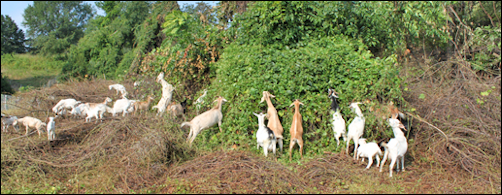by James A. Bacon
A common reed plant, known by the scientific name of Phragmites australis, introduced into the United States in the 18th century from Europe, has invaded the eastern marshes of North America. Like many invasive species, Phragmites out-competes native marsh plants. When the reed establishes expansive mono-cultures, plant diversity declines precipitously. And when plant diversity declines, so does the diversity of insects and the rest of the food chain dependent upon the plants.
Over the past five years, land managers and private organizations have treated more than 80,000 hectares of marsh with herbicides at a cost of $4.6 million per year to control Phragmites. Mowing and burning the plant hasn’t proven economical, given high labor costs. And insect control often does greater damage to native strains than to the invasive plant.
In desperation, the marine science and conservation division of Duke University tested a new technique for controlling the plant: grazing goats. At a fresh water marsh in Beltsville, Md., the scientists penned goats in enclosures where they had little but Phragmites to eat. While the goats didn’t eradicate the plant pest, they substantially reduced its biomass — from 94% of ground cover to 21% on average — allowing native species a better chance of competing, investigators concluded.
Across the country, government authorities are discovering the virtues of goats for clearing unwanted brush, even tending lawns. The hardy ruminants have an appetite for plants that other animals shun.
There is a small but active goat industry in Virginia. The Virginia State Dairy Goat Association lists 33 members. Jack & Anita Mauldin’s Boer Goats page lists 34 goat farms. My impression is that most goat products fall into the organic or artisanal agriculture category — goat meat, goat cheese, goat milk, maybe some goat wool. But perhaps the most interesting enterprise is Goat Busters, based in Afton, which specializes in land clearing. As its website says, “Goat Busters is quite simply the most environmentally sensitive method to clear land or control invasive species vegetation ever, short of going out and hand-pulling each and every little weed.”
Bacon’s bottom line: Virginia government, businesses and property owners need to Get Goat. They should more aggressively explore the use of goats as a tool for clearing brush and controlling invasive species. Transporting the goats and setting up the pens is more labor intensive than attacking a patch of brush or Phragmites with a Bush Hog or a tankful of herbicides, but goats don’t compact the soil and they don’t leave behind chemical compounds laden with heavy metals. They do leave behind fertilizer, enriching the soil.
In economic development parlance, substituting locally raised goats for imported herbicides and rotary mowers is called “import substitution.” The practice keeps money in the region, supporting local enterprises and jobs. It’s hard to imagine the goat industry transforming the face of Virginia agriculture, but every little bit helps make our rural counties more economically viable.



